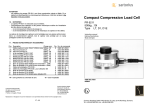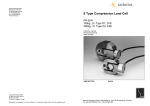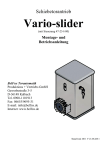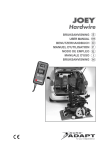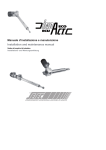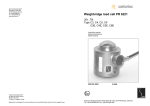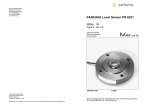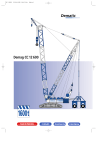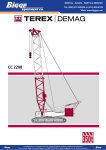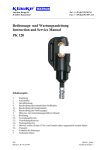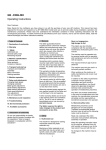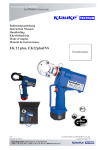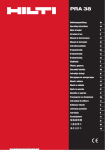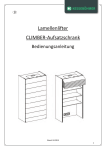Download MiniFLEXLOCK PR 6143
Transcript
MiniFLEXLOCK PR 6143 Type PR 6143/00N+S PR 6143/10N+S 9405 361 43.0. Instruction manual Gebrauchsanleitung Mode d’emploi 9499 053 14401 Fifth edition 970515 Philips Weighing E W ©Philips Wägetechnik GmbH Meiendorfer Straße 205, 22145 Hamburg 1997 All rights are strictly reserved. Reproduction or divulgation in any form whatsoever is not permitted without written authority from the copyright owner. Printed in Germany 5th edition 5. Ausgabe 5e tirage E-1 MiniFLEXLOCK PR 6143 CONTENTS 1 Purpose and application 2. Technical data 3. Installation 4. Maintenance 5. Spare parts and accessories E-1 E-2 E-2 E-4 E-4 Fig. 1 Fig. 2 Fig. 3 Fig. 4 Fig. 5 Fig. 6 Fig. 7 Fig. 8 Fig. 9 Fig. 10 A-1 A-1 A-2 A-3 A-4 A-5 A-5 A-6 A-6 A-7 Fig. 11 Fig. 12 Fig. 13 Fig. 14 Fig. 15 Fig. 16 PR 6143 Arrangement of load cells and mounting kits MiniFLEXLOCK PR 6143/00 N + S MiniFLEXLOCK PR 6143/10 N + S Load cell dummy Loosen the two upper mounting bolts Position the load cell vertically in the mounting unit Mounting of the upper load disc Positioning of the load disc Insert the load disc in the upper mounting plate and lower the assembly onto the load cell Secure the mounting plate in the horizontal position and tighten bolts Secure the mounting unit horizontally between two parallel surfaces Tighten the bolts crosswisely (in the order 1...6) Spare parts and accessories Permissible inclination Protection against lift-off A-7 A-8 A-8 A-9 A - 10 A - 11 1. PURPOSE AND APPLICATION MiniFLEXLOCK PR 6143 is a mounting kit for PHILIPS PR 6201 load cells with a load rating of 0.5t to 50t, which also provides horizontal constraining of the object to be weighed. The kit is prepared for construction of a protection against lifting. MiniFLEXLOCK is an optimum solution for quick and easy mounting of vessels on three or more load cells. The examples in Fig. 2 show various solutions for installation of load cells with PR 6143 constraining units and PR 6145 mounting kits. In order to ensure the required space for movement of the weighing facility, max. three MiniFLEXLOCK kits may be used for constraining an object. When using a higher number of load cells than 3, the remaining load cells must be installed with mounting kit PR 6145/00. Constraining of the object to be weighed is done in X direction (see Fig. 1). The required space for normal thermal expansion is ensured in Y direction. Mounting kit PR 6143/00N PR 6143/00S PR 6143/10N PR 6143/10S Nominal force 20kN 17kN 50kN 45kN Material Steel, zinc-plated, yellow chromated Stainless steel Steel, zinc-plated yellow chromated Stainless steel A stainless steel pressure plate (marked with "SS") and a food-resistant silicone O-ring (light beige) are delivered with the stainless steel mounting kits (PR 6143/00S and /10S). These parts must be used instead of standard pressure plate (without marking) and dark gray standard O-ring. During transport and installation, the constraining unit is held together by an auxiliary mounting plate, which must be removed after installation. Additional hints on load cell arrangement and behaviour with horizontal forces are given in the load cell operating instructions. 2. TECHNICAL DATA E-2 For rated load cell capacity Max. horizontal force in Xdirection (nominal force) Horizontal destructive load in Xdirection Max. permitted movement in Ydirection Thread size for mounting bolts Minimum rigidity class of mounting bolts (ISO 898) Permissible temperature range Dimensions Weight (net) Weight (with packing) Material PR 6143/00N 0.5...20t 20kN PR 6143/00S 0.5...20t 17kN PR 6143/10N 0.5...50t 50kN PR 6143/10S 0.5...50t 45kN >40kN >40kN >70kN >70kN - limited by the maximum permitted inclination of the load cells M12 5.8 M12 A2 -40°C...+80°C -40°C...+80°C see fig. 3 10.5kg 11.6kg 11.3kg 12.4kg steel, with zinc- stainless steel, plated surface, 1.4301 acc. to DIN 17440 yellow chromated M14 8.8 M14 A2 -40°C...+80°C -40°C...+80°C see fig. 4 15.8kg 17.5kg 17.1kg 19.3kg steel, with zinc- stainless steel, plated surface, 1.4301 acc. to DIN 17440 yellow chromated 3. INSTALLATION 3.1 Before mounting To ensure an invariably high weighing accuracy, the foundation for the mounting kit must be horizontal (use spirit level), flat and rigid for the loads to be supported. In order to prevent partial overloading of the load cells, the load must be distributed as symmetrical as possible. Therefore, the foundations of the mounting kits must be aligned and the supporting surfaces of the weighing object (vessel or platform) must mounted in parallel. The bore holes of upper and lower mounting plate must coincide. Bolts M12, min. rigidity class 5.8 (to ISO 898) are required for mounting constraining unit PR 6143/00N. For PR 6143/10N, bolts M14, min. rigidity class 8.8, are required. 3.2 Auxiliary facilities for mounting and alignment To prevent damage of the load cell due to overload during mounting, dummies instead of load cells (as shown in Fig. 5) can be used. These dummies must be produced at the site in each individual case. They are inserted during installation of the mounting kits and ensure exact alignment of mounting kits and weighing installation. The dummies are replaced by the load cells only when all mechanical and alignment work as well as welding near the load cell are finished. 3.3 Pre-assembly of mounting kit and load cell Mounting constraining unit and load cell is done as shown in Fig. 6 to 11 following the mounting hints given in the load cell operating instructions. • Release the upper bolts of the auxiliary mounting plate (Fig. 6) and fold the upper mounting plate away. Insert the dummy, or, if no dummy is provided, the load cell with the load disc as shown in Fig. 7 to 11. • When using a stainless steel MiniFLEXLOCK (version S), the pressure plate marked with "SS" (Fig. 14, part 2) and the food-resistant O-ring (light beige) must be used. In this case, the standard pressure plate (without stamp) and the dark gray standard O-ring are not required. • Connect upper and lower mounting plate with flexible copper strap (packed with the load cell). Two bolts M8 and washers for locking are delivered with the mounting kit. • Re-mount the upper mounting plate at the auxiliary plate. 3.4 Mounting the pre-assembled unit Mount the pre-assembled unit between horizontally two parallel surfaces. E-3 • Mount lower and upper mounting plate by means of bolts and washers to foundation and weighing object support (vessel, platform, etc.). • When all constraining units and mounting kits are mounted at the weighing facility, remove the auxiliary mounting plates (tighten the relevant bolts in the threaded holes of the mounting plates) and align the mounting plates so that the dummies stand uncantedly and in exact vertical position. If required, release the mounting bolts slightly and adjust the mounting plates. For this purpose, the holes offer some free space. • Tighten the mounting bolts crosswisely in the order 1...6 (Fig. 13). Mounting kit PR 6143/00N PR 6143/00S PR 6143/10N PR 6143/10S Bolt M12 M12 M14 M14 Rigidity class 5.8 A2 8.8 A2 Mounting torque 104Nm 104Nm 165Nm 165Nm • Only when all welding work near the load cell and mounting and alignment at the object to be weighed are finished, lift the object and replace the dummy by the load cell. Take care that the load disc is positioned correctly. The load cell must stand vertically and untiltedly after installation. 3.5 Check after the installation After the installation of all mounting kits and load cells, the correct mounting must be checked. In particular, force shunts must be avoided. • Check, if the constrainer is free of load, i.e. if it can be rotated around its longitudinal axis. If this is not the case, release the counter-nuts (Fig. 14, part 5) of the constrainer, and turn the hexagon (6), until the constrainer is free of load. Subsequently, re-tighten the counter nuts and position the swivel bearing eyes vertically. After mounting, check by means of Fig. 14, • if the load cell stands untiltedly in the mounting kit, • if the upper mounting plate is positioned horizontally, and • if there is vertical space for movement and the required space for thermal expansion. The permissible tolerances without considerable effect on the accuracy are given in Fig. 15. The space for movement required for displacement of the object to be weighed due to thermal expansion, vibration, etc. can be used only if load cell and constraining unit are installed exactly. To prevent vertical force shunts, all mechanical connections (pipes, cables, bellows) of the object to be weighed to its surrounding construction must be as flexible as possible. The overall load must be supported by the load cells. E-4 3.6. Protection against lifting A protection against lifting is generally recommendable. It can be realized as shown in Fig. 16. For this, a stud, three nuts and two washers are required. • Take care that the stud (7) has sufficient space for movement in the bore hole (8). • Counter nuts (9) so that there is a remaining distance (X) of 1mm (± 0.5 mm) to the washer (10). Note that 1 mm (±0.5) space for lifting is indispensable. Mounting kit PR 6143/00 PR 6143/10 Stud M16 M20 Rigidity class (ISO 898) 5.8 5.8 Permissible load 20kN 50kN 4. MAINTENANCE • Mounting kits and load cells need no maintenance. • During a service inspection, the bolts fixing the constrainer must be inspected: every bolt must be fixed with two safety clips to prevent it from sliding out. 5. SPARE PARTS AND ACCESSORIES Pos 1 2 3 4 5 6 7 8 9 Description load disc, standard, PR 6143/50N load disc, stainless steel, PR 6143/50S bottom plate with O-ring, standard bottom plate with O-ring, standard O-ring, standard (dark grey) O- ring, food resistance (light beige) bottom plate with O- ring, stainless steel, PR 6143/24S bottom plate with O- ring, stainless steel, PR 6143/54S flexible copper strap, 16mm2, 400mm long Nom. load 0.5...50t 0.5...50t 0.5...20t 30....50t 0.5...50t 0.5...50t 0.5...20t 30....50t 0.5...50t Fig. 14 - 1 14 - 1 14 - 2,3 14 - 2,3 14 - 3 14 - 3 14 - 2 14 - 2 14 - 4 Order code 9405 361 43501 9405 361 43502 5322 693 91164 5322 693 91165 5322 532 70298 5322 532 70317 9405 361 43242 9405 361 43542 5322 310 30581 All above mentioned parts are available at the national W service organisations for electronic weighing. D-1 MiniFLEXLOCK PR 6143 INHALT 1. 2. 3. 4. 5. Fig. 1 Fig. 2 Fig. 3 Fig. 4 Fig. 5 Fig. 6 Fig. 7 Fig. 8 Fig. 9 Fig. 10 Fig. 11 Fig. 12 Fig. 13 Fig. 14 Fig. 15 Fig. 16 Zweck und Anwendung Technische Daten Installation Wartung Ersatzteile und Zubehör D-1 D-2 D-2 D-4 D-4 PR 6143 Anordnung der Wägezellen und Einbausätze MiniFLEXLOCK PR 6143/00 N+S MiniFLEXLOCK PR 6143/10 N+S Wägezellennachbildung Lösen der beiden oberen Schrauben Wägezelle senkrecht einsetzen Einbauweise des oberen Druckstückes Einbaulage des oberen Druckstückes Druckstück in die obere Montageplatte einlegen und Montageeinheit schließen Obere Montageplatte horizontal ausrichten und Schrauben wieder anziehen Montageeinheit zwischen zwei horizontal ausgerichteten Montageflächen montieren Schrauben über Kreuz anziehen (Reihenfolge 1...6) Ersatzteile und Zubehör Maximale Schiefstellung Abhebesicherung A-1 A-1 A-2 A-3 A-4 A-5 A-5 A-6 A-6 A-7 A-7 A-8 A-8 A-9 A - 10 A - 11 1. ZWECK UND ANWENDUNG Die MiniFLEXLOCK PR 6143 ist ein Einbausatz für PHILIPS Wägezellen PR 6201 mit Nennlasten von 0,5t bis 50t. Gleichzeitig fesselt sie das Wägeobjekt horizontal. Sie ist vorbereitet für den Aufbau einer Abhebesicherung. Die MiniFLEXLOCK ist die optimale Lösung, um Behälter schnell und einfach auf drei oder mehr Wägezellen zu montieren. Fig. 2 zeigt beispielhaft unterschiedliche Anordnungen von Wägezellen mit Fesselungseinheiten PR 6143 und Einbausätzen PR 6145. Um die erforderliche Bewegungsfreiheit der Meßeinrichtung zu gewährleisten, dürfen höchstens drei MiniFLEXLOCK zur Fesselung eines Wägeobjekts eingesetzt werden. Bei Verwendung von mehr als 3 Wägezellen sind die weiteren mit dem Einbausatz PR 6145/00 zu installieren. Die Fesselung des Wägeobjekts erfolgt in Lenkerlängsrichtung (X -Richtung), siehe Fig. 1. Die nötige Bewegungsfreiheit für die normale thermische Dehnung ist in der Lenkerquerrichtung (Y - Richtung) gewährleistet. Einbausatz PR 6143/00N PR 6143/00S PR 6143/10N PR 6143/10S Nennkraft 20kN 17kN 50kN 45kN Material Stahl, verzinkt, gelb chromatiert Edelstahl rostfrei Stahl, verzinkt, gelb chromatiert Edelstahl rostfrei Den Einbausätzen aus rostfreiem Edelstahl (PR 6143/00S und /10S) liegen ein Fußstück aus rostfreiem Edelstahl (mit "SS" gekennzeichnet) und ein lebensmittelbeständiger Dichtring aus Silikon (hellbeige) bei. Diese Teile sind anstelle des Standard-Fußstückes (ohne Kennzeichnung) und des dunkelgrauen Standard-Dichtringes zu verwenden. Für Transport und Installation wird die Fesselungseinheit von einem Montagehilfsblech zusammengehalten. Dieses muß nach der Installation entfernt werden. Weitere Hinweise über die Anordnung der Wägezellen und das Verhalten bei Querkräften sind der Gebrauchsanleitung der verwendeten Wägezelle zu entnehmen. 2. TECHNISCHE DATEN D-2 für Wägezellen Nennlast max. Horizontalkraft in XRichtung (Nennkraft) horizontale Bruchlast in XRichtung max. erlaubte Bewegung in YRichtung Gewindegröße der Montageschrauben Mindestfestigkeitsklasse der Montageschrauben (ISO 898) zulässiger Temperaturbereich Abmessungen Gewicht (netto) Gewicht (mit Verpackung) Material PR 6143/00N 0,5...20t 20kN PR 6143/00S 0,5...20t 17kN PR 6143/10N 0,5...50t 50kN PR 6143/10S 0,5...50t 45kN >40kN >40kN >70kN >70kN M12 5.8 wird begrenzt durch die maximal erlaubte Schiefstellung der Wägezellen M12 M14 M14 A2 -40°C...+80°C -40°C...+80°C siehe Fig. 3 10,5kg 11,6kg 11,3kg 12,4kg rostfreier Stahl, Oberfläche ver-zinkt, Edelstahl 1.4301 nach gelb DIN 17440 chromatiert 8.8 A2 -40°C...+80°C -40°C...+80°C siehe Fig. 4 15,8kg 17,5kg 17,1kg 19,3kg rostfreier Stahl, Oberfläche ver-zinkt, Edelstahl 1.4301 nach gelb DIN 17440 chromatiert 3. INSTALLATION 3.1 Vor der Montage Für eine gleichbleibende hohe Meßgenauigkeit muß das Fundament für den Einbausatz waagerecht (Wasserwaage benutzen), eben und unnachgiebig für die vorgesehenen Lasten sein. Um die Wägezellen nicht partiell zu überlasten, muß die Belastung möglichst gleichmäßig verteilt werden. Deshalb müssen die Fundamente der Einbausätze auf gleicher Höhe und die Auflageflächen des Wägeobjekts (Behälter oder Plattform) parallel angeordnet sein. Die Bohrbilder der oberen und unteren Montageplatte müssen deckungsgleich übereinander liegen. Zur Montage der Fesselungseinheit PR 6143/00N sind Schrauben M12, Mindest-Festigkeitsklasse 5.8 (nach ISO 898), für PR 6143/10N Schrauben M14, Mindest-Festigkeitsklasse 8.8 erforderlich. 3.2 Montage- und Ausrichthilfen Um die Wägezellen bei der Montage nicht durch Überlastungen zu beschädigen, können stattdessen Stempel als Wägezellennachbildung ähnlich Fig. 5 verwendet werden. Diese sind im Einzelfall vor Ort anzufertigen. Diese Stempel werden bei der Montage der Einbausätze eingesetzt und gewährleisten eine genaue Ausrichtung der Einbausätze und der Wägeinstallation. Erst wenn alle mechanischen und Ausrichtarbeiten sowie alle Schweißarbeiten in der Umgebung der Wägezelle beendet sind, werden die Wägezellen anstelle der Stempel eingebaut. 3.3 Vormontage von Einbausatz und Wägezelle Die Montage der Fesselungseinheit und der Wägezelle erfolgt entsprechend Fig. 6 bis 11. Dabei sind die Montagehinweise in der Gebrauchsanleitung der Wägezelle zu beachten. • Die oberen Schrauben des Montagehilfsbleches herausdrehen (Fig. 6) und die obere Montageplatte wegklappen. Stempel oder, wenn nicht vorhanden, Wägezelle mit Druckstück entsprechend Fig. 7 bis 11 einsetzen. D-3 • Bei Einsatz der MiniFLEXLOCK aus rostfreien Edelstahl (S-Version) sind das der Fesselung beigelegte, mit "SS" markierte Fußstück (Fig. 14, Teil 2) und der zugehörige nahrungsmittelbeständige Dichtring (hellbeige) zu verwenden. Das Standard-Fußstück (ohne Stempelung) und der dunkelgraue StandardDichtring werden in diesem Fall nicht benötigt. • Obere und untere Montageplatte mit flexiblem Kupferkabel verbinden (ist der Wägezelle beigepackt). Zwei Schrauben M8 und Federringe zur Befestigung sind im Einbausatz enthalten. • Obere Montageplatte wieder an das Montagehilfsblech schrauben. 3.4 Einbau der vormontierten Einheit Die vormontierte Einheit zwischen zwei horizontal ausgerichteten Montageflächen montieren. • Untere und obere Montageplatte mit Schrauben und Federringen an Fundament und WägeobjektAuflage (Behälter, Plattform etc.) anschrauben. • Erst wenn alle Fesselungseinheiten und Einbausätze an der Wägeeinrichtung montiert sind, die Montagehilfsbleche entfernen (die zugehörigen Schrauben in die Gewindelöcher der Montageplatten schrauben) und die Montageplatten so ausrichten, daß die Wägezellennachbildungen bzw. Wägezellen unverkantet und genau senkrecht stehen. Falls erforderlich, die Montageschrauben etwas lösen und die Montageplatten verschieben, die Schraubenlöcher bieten etwas Freiraum. • Montageschrauben kreuzweise in der Reihenfolge 1...6 (Fig. 13) festziehen. Einbausatz PR 6143/00N PR 6143/00S PR 6143/10N PR 6143/10S Schraube M12 M12 M14 M14 Mindest- Festigkeitsklasse 5.8 A2 8.8 A2 Anzugsmoment 104Nm 104Nm 165Nm 165Nm • Erst wenn alle Schweißarbeiten in der Nähe der Wägezelle und die Montage- und Ausrichtarbeiten am Wägeobjekt beendet sind, wird das Wägeobjekt angehoben und die Wägezellennachbildung gegen die Wägezelle ausgewechselt. Auf die richtige Position des Druckstücks achten. Die Wägezelle muß nach dem Einbau senkrecht und unverkantet stehen. 3.5 Überprüfung nach dem Einbau Wenn alle Einbausätze installiert sind, ist der ordnungsgemäße Einbau zu überprüfen. Insbesondere müssen Kraftnebenschlüsse vermieden werden. • Prüfen, ob der Lenker lastfrei ist, d.h. sich um seine Längsachse drehen läßt. Ist das nicht der Fall, die Kontermuttern (Fig. 14, Teil 5) des Lenkers lösen und das Sechskant (6) verdrehen, bis der Lenker lastfrei ist. Anschließend die Kontermuttern wieder anziehen und die Gelenkaugen senkrecht stellen. Weiterhin ist nach der Montage zu überprüfen, • ob die Wägezelle unverkantet im Einbausatz steht, • ob die obere Montageplatte waagerecht sitzt und • ob vertikale Bewegungsfreiheit und das erforderliche Spiel für thermische Dehnung gegeben sind. Nur bei exakt eingebauter Wägezelle und Fesselungseinheit kann die Bewegungsfreiheit, die für Verlagerungen des Meßobjekts durch thermische Dehnung, Vibration o.ä. erforderlich ist, ohne Einschränkung der Meßgenauigkeit genutzt werden. Fig. 15 zeigt die erlaubten Abweichungen, die zu keiner wesentlichen Beeinflussung der Meßgenauigkeit führen. Zur Vermeidung von Kraftnebenschlüssen sind alle Zu- und Ableitungen (Schläuche, Rohre, Kabel) so flexibel wie möglich an das Meßobjekt zu koppeln. Die gesamte Last muß von den Wägezellen getragen werden. 3.6 Abhebesicherung (Fig. 16) Eine Abhebesicherung ist aus Sicherheitsgründen generell empfehlenswert. Diese kann entsprechend D-4 Fig. 16 verwirklicht werden. Dafür sind eine Gewindestange, drei Muttern und zwei Unterlegscheiben erforderlich. • Die Gewindestange (7) muß ausreichend Bewegungsfreiheit in der Bohrung (8) haben. • Muttern (9) so kontern, daß 1mm (± 0,5 mm) Abstand (X) zur Unterlegscheibe (10) verbleibt. Diese Hebefreiheit von 1mm (±0,5) ist unbedingt einzuhalten werden, um Kraftnebenschlüsse zu vermeiden. Einbausatz PR 6143/00 PR 6143/10 Gewindestange M16 M20 Festigkeitsklasse (ISO 898) 5.8 5.8 Belastbarkeit 20kN 50kN 4. WARTUNG • Einbausätze und Wägezellen sind wartungsfrei. • Im Rahmen einer Service- Überprüfung sind die Haltebolzen des Querlenkers zu inspizieren: jeder Haltebolzen mit mit zwei Sicherungen, die ihn am Herausrutschen hindern, festgehalten sein. 5. ERSATZTEILE UND ZUBEHÖR Pos. Bezeichnung für Laststufe Fig. Bestell- Nr. 1 Druckstück oben, Standard, PR 6143/50N 0,5...50t 14 - 1 9405 361 43501 2 Druckstück oben, rostfreier Edelstahl, PR 6143/50S 0,5...50t 14 - 1 9405 361 43502 3 Fußstück mit Dichtring, Standard 0,5...20t 14 - 2,3 5322 693 91164 4 Fußstück mit Dichtring, Standard 30....50t 14 - 2,3 5322 693 91165 5 Dichtring, Standard (dunkelgrau) 0,5...50t 14 - 3 5322 532 70298 6 Dichtring, Lebensmittelqualität (hellbeige) 0,5...50t 14 - 3 5322 532 70317 7 Fußstück mit Dichtring, rostfreier Edelstahl, PR 6143/24S 0,5...20t 14 - 2 9405 361 43242 8 Fußstück mit Dichtring, rostfreier Edelstahl, PR 6143/54S 30....50t 14 - 2 9405 361 43542 9 Flexible Kupferleitung 16mm2, 400mm lang 0,5...50t 14 - 4 5322 310 30581 Alle oben aufgeführten Teile können bei den nationalen W Service- Organisationen für Wägetechnik bestellt werden. F-1 MiniFLEXLOCK PR 6143 TABLE DES MATIÈRES 1. But et utilisation 2. Caractéristiques techniques 3. Installation 4. Entretien 5. Pièces de rechange et accessoires Fig. 1 Fig. 2 Fig. 3 Fig. 4 Fig. 5 Fig. 6 Fig. 7 Fig. 8 Fig. 9 Fig. 10 Fig. 11 Fig. 12 Fig. 13 Fig. 14 Fig. 15 Fig. 16 F-1 F-2 F-2 F-4 F-4 PR 6143 Disposition de capteurs et de kits de montage MiniFLEXLOCK PR 6143/00 N+S MiniFLEXLOCK PR 6143/10 N+S Mannequin de montage Desserrer les deux vis supérieures Insérer le capteur de pesage verticalement Montage de l’anneau de pression supérieur Position de montage de l’anneau de pression supérieur Insérer l’anneau de pression dans la plaque de montage supérieure, et fermer l’unité de montage Ajuster la plaque de montage horizontalement, et resserrer les vis Installer l’unité de montage horizontalement entre deux surfaces parallèles Serrer les boulons de montage alternativement selon l’ordre 1..6 Pièces de rechange et accessoires Inclinaison admissible Protection contre le basculement A-1 A-1 A-2 A-3 A-4 A-5 A-5 A-6 A-6 A-7 A-7 A-8 A-8 A-9 A - 10 A - 11 1. BUT ET UTILISATION MiniFLEXLOCK PR 6143 est un kit de montage pour les capteurs de pesage PR 6201 W d'une capacité nominale de 0,5t à 50t. Ce kit de montage assure également la contrainte horizontale de l'objet à peser. Il est préparé pour la construction d'une protection contre le basculement. L'unité MiniFLEXLOCK est une solution optimale pour le montage rapide et facile de réservoirs sur trois ou plus de capteurs de pesage. Les exemples dans la fig. 2 illustrent plusieurs solutions pour l'installation de capteurs de pesage avec des unités de contrainte PR 6143 et des kits de montage PR 6145. Afin de garantir la plage requise pour le mouvement du dispositif de pesage, max. trois kits MiniFLEXLOCK peuvent être utilisés pour la contrainte d'un objet à peser. Lorsqu'on utilise un nombre plus élevé de 3 capteurs de pesage, les autres capteurs doivent être installés avec le kit de montage PR 6145/00. La contrainte de l'objet à peser est réalisée dans le sens X (voir la fig. 1). La plage requise pour la dilatation thermique normale est garantie dans le sens Y. Kit de montage PR 6143/00N PR 6143/00S PR 6143/10N PR 6143/10S Force nominale 20kN 17kN 50kN 45kN Matière Acier, passivé au chromate de zinc Acier inoxydable Acier, passivé au chromate de zinc Acier inoxydable Une plaque de pression en acier inoxydable (marquée *SS+) et un joint torique en silicone résistant aux produits alimentaires (beige clair) sont livrés avec les kits de montage en acier inoxydable (PR 6143/00S et /10S). Ces pièces doivent être utilisées au lieu de la plaque de pression standard (non marquée) et du joint torique standard gris foncé. Pendant le transport et l'installation, l'unité de contrainte est maintenue par une plaque de montage auxiliaire. Cette plaque doit être enlevée après l'installation. Pour des renseignements supplémentaires sur l'arrangement des capteurs de pesage et le comportement en présence de forces horizontales, voir les mode d'emploi des capteurs de pesage. F-2 2. CARACTÉRISTIQUES TECHNIQUES Pour capacités nom. capteur Force horizontale max dans le sens X (force nom.) Charge de rupture horizontale dans le sens X Mouvement max. admissible dans le sens Y Calibre du filet des boulons de montage Classe de rigidité min. des boulons de montage (ISO 898) Plage de température admissible Dimensions Poids (net) Poids (avec emballage) Matière PR 6143/00N 0,5...20t 20kN PR 6143/00S 0,5...20t 17kN PR 6143/10N 0,5...50t 50kN PR 6143/10S 0,5...50t 45kN >40kN >40kN >70kN >70kN limité par l’inclinaison maximale des capteurs de pesage M12 M12 M14 M14 5.8 A2 8.8 A2 -40°C...+80°C -40°C...+80°C -40°C...+80°C -40°C...+80°C voir la fig. 3 10,5kg 11,6kg 11,3kg 12,4kg acier inoxydable acier, surface 1.4301 selon passivée au DIN 17440 chromate de zinc voir la fig. 4 15,8kg 17,5kg 17,1kg 19,3kg acier acier, surface inoxydable passivée au 1.4301 selon chromate de DIN 17440 zinc 3. INSTALLATION 3.1 Avant le montage Afin de garantir une précision de pesage invariablement élevée, la fondation pour le kit de montage doit être horizontale (utiliser un niveau d'air), plate et rigide pour les charges prévues. Pour éviter une surcharge partielle des capteurs de pesage, la charge doit être distribuée le plus symétriquement possible. A cet effet, les fondations des kits de montage doivent être alignées et les surfaces portant l'objet à peser (réservoir ou plate-forme) doivent être montées en parallèle. Les trous dans les plaques de montage supérieure et inférieure doivent coïncider. Utiliser des boulons M12, classe de rigidité min. 5.8 (selon ISO 898) pour le montage de l'unité de contrainte PR 6143/00N, et des boulons M14, classe de rigidité min. 8.8, pour le montage de PR 6143/10N. 3.2 Dispositifs auxiliaires pour le montage et l'alignement Afin d'éviter l'endommagement des capteurs de pesage dû à une surcharge pendant le montage, on peut utiliser des mannequins de montage au lieu de capteurs de pesage (comme illustrés dans la fig. 5). Ces mannequins de montage sont à produire sur le site dans chaque cas individuel. Ils sont utilisés pendant l'installation des kits de montage et garantissent l'alignement exact des kit de montage et de l'installation de pesage. Les mannequins de montage sont à remplacer par les capteurs de pesage seulement après avoir achevé tous les travaux mécaniques et les travaux d'alignement et de soudage près du capteur de pesage. 3.3 Assemblage du kit de montage et du capteur de pesage Le montage de l'unité de contrainte et du capteur de pesage s'effectue comme illustré dans les fig. 6 à 11 suivant les instructions des notices d'utilisation du capteur de pesage. • Desserrer les boulons supérieurs de la plaque de montage auxiliaire (Fig. 6) et plier la plaque de montage supérieure vers le côté. Insérer le mannequin de montage, ou, s'il n'y en a pas, le capteur de pesage avec la pièce de pression comme illustré dans les fig. 7 à 11. • Lorsqu'on utilise un MiniFLEXLOCK en acier inoxydable (version S), la plaque de pression marquée *SS+ (Fig. 14, pièce No. 2) et le joint torique résistant aux produits alimentaires (beige clair) doivent être utilisés. Dans un tel cas, la plaque de pression standard (sans empreinte) et le joint torique standard gris ne sont pas requis. • Relier les plaques de montage supérieure et inférieure à l'aide du câble souple en cuivre (emballé F-3 avec le capteur de pesage). Deux boulons M8 et des rondelles pour le blocage sont contenues dans le kit de montage. • Remonter la plaque de montage supérieure à la plaque de montage auxiliaire. 3.4 Installation • Visser les plaques de montage supérieure et inférieure à la fondation et au support de l'objet à peser (réservoir, plate-forme, etc.) à l'aide de boulons et de rondelles. • Lorsque toutes les unités de contrainte et les kits de montage ont été montés sur le dispositif de pesage, enlever les plaques de montage auxiliaires (serrer les boulons dans les trous filetés des plaques de montage) et aligner les plaques de montage d'une manière que les mannequins de montage soient dans une position horizontale exacte, sans être coincés. Si nécessaire, desserrer les boulons de montage légèrement et ajuster les plaques de montage dans les trous. • Serrer les boulons de montage alternativement selon l'ordre 1...6 (Fig. 13). Kit de montage PR 6143/00N PR 6143/00S PR 6143/10N PR 6143/10S Boulon M12 M12 M14 M14 Classe de rigidité 5.8 A2 8.8 A2 Couple de montage 104Nm 104Nm 165Nm 165Nm • Seulement après avoir achevé tous les travaux de soudage près du capteur de pesage et les travaux de montage et d'alignement à l'objet à peser, soulever l'objet à peser et remplacer le mannequin de montage par le capteur de pesage. Faire attention à ce que la position de la pièce de pression soit correcte. Après l'installation, le capteur de pesage doit être positionné verticalement, sans être coincé. 3.5 Contrôle après l’installation Si tous les kits de montage sont installés, contrôler l’installation. En particulier, des erreurs occasionnées par le connexions à l’objet à peser doivent être évités. • Vérifier si le dispositif de guidage est libre de charge, c.à.d. s'il peut être tourné autour de son axe longitudinale. Si ceci n'est pas possible, desserrer les contre-écrous (Fig. 14, pièce 5) du dispositif de guidage, et tourner l'hexagone (6), jusqu'à ce que le dispositif soit libre de charge. Ensuite, resserrer les contre-écrous et positionner les paliers pivotants verticalement. Après le montage, vérifier, • si le capteur n'est pas coincé dans le kit de montage, • si la plaque de montage supérieure est positionnée horizontalement, et • si la plage verticale pour le mouvement et la dilatation thermique est suffisante. La mise en valeur de la plage requise pour le déplacement de l'objet à peser dû à la dilatation thermique, la vibration, etc. est possible seulement si le capteur de pesage et l'unité de contrainte ont été installés exactement. Les tolérances admissibles sans effet considérable sur la précision sont illustrées dans la fig. 15. Afin d'éviter des erreurs occasionnées par les connexions à l'objet à peser (tuyaux, câbles, soufflets, etc.), ceux-ci doivent être raccordés de la façon la plus souple possible. 3.6. PROTECTION CONTRE LE BASCULEMENT (fig. 16) Une protection contre le basculement est généralement recommandable. Elle peut être réalisée comme illustrée dans la fig. 16. Pour cela, une tige filetée, trois écrous et deux rondelles sont requis. Faire attention à ce que la plage pour le mouvement de la tige filetée (7) dans le trou (8) soit suffisante. Bloquer les écrous (9) d'une manière que la distance (X) de la rondelle (10) soit d'1mm (± 0,5 mm). Noter qu'une plage d'1 mm (±0,5) pour le basculement est indispensable. F-4 Kit de montage PR 6143/00 PR 6143/10 Tige filetée M16 M20 Classe de rigidité (ISO 898) 5.8 5.8 Charge admissible 20kN 50kN 4. ENTRETIEN • Les kits de montage et les capteurs de pesage ne nécessitent aucun entretien. • Pendant une inspection de service, les axes du dispositif de guidage doivent être contrôlés: chaque axe doit être assuré de deux disques de butée. 5 PIÈCES DE RECHANGE ET ACCESSOIRES Pos. 1 2 3 Description Charges nominales Fig. No. de commande Pièce de pression standard, PR 6143/50N 0,5...50t 14 - 1 9405 361 43501 Pièce de pression, acier inox., PR 6143/50S 0,5...50t 14 - 1 9405 361 43502 Plaque de pression avec joint anneau, 0,5...20t 14 - 2,3 5322 693 91164 standard 4 Plaque de pression avec joint anneau, 30...50t 14 - 2,3 5322 693 91165 standard 5 Joint anneau, standard (gris foncé) 0,5...50t 14 - 3 5322 532 70298 6 Joint anneau, résistant aux produits 0,5...50t 14 - 3 5322 532 70317 alimentaires (beige clair) 7 Plaque de pression, acier inox., PR 6143/24S 0,5...20t 14 - 2 9405 361 43242 8 Plaque de pression, acier inox., PR 6143/54S 30...50t 14 - 2 9405 361 43542 9 Câble souple, cuivre, 16mm2, longueur 0,5...50t 14 - 4 5322 310 30581 400mm Toutes les pièces mentionnées ci-dessus peuvent être commandées au département SERVICE de l’organisation nationale pour pesage électronique. A-2 Fig. 3 MiniFLEXLOCK PR 6143/00 N+S A-6 Fig. 8 Mounting the upper load disc Einbauweise des oberen Druckstückes Montage de la pièce de pression supérieur All dimensions in mm Alle Abmessungen in mm Toutes dimensions en mm Accuracy class Genauigkeitsklasse Classe de précision L D1, C1,5, C3 Fig. 9 Nominal load Nennlast Charge nominale 0.5t...20t 0.5t...10t Accuracy class Genauigkeitsklasse Classe de précision L D1, C1,5, C3 Nominal load Nennlast Charge nominale 50t 20t...50t Positioning of the load disc Einbaulage des oberen Druckstückes Position de montage de la pièce de pression supérieur A-9 Fig. 14 Spare parts and accessories Ersatzteile und Zubehör Pièces de rechange et accessoires

















